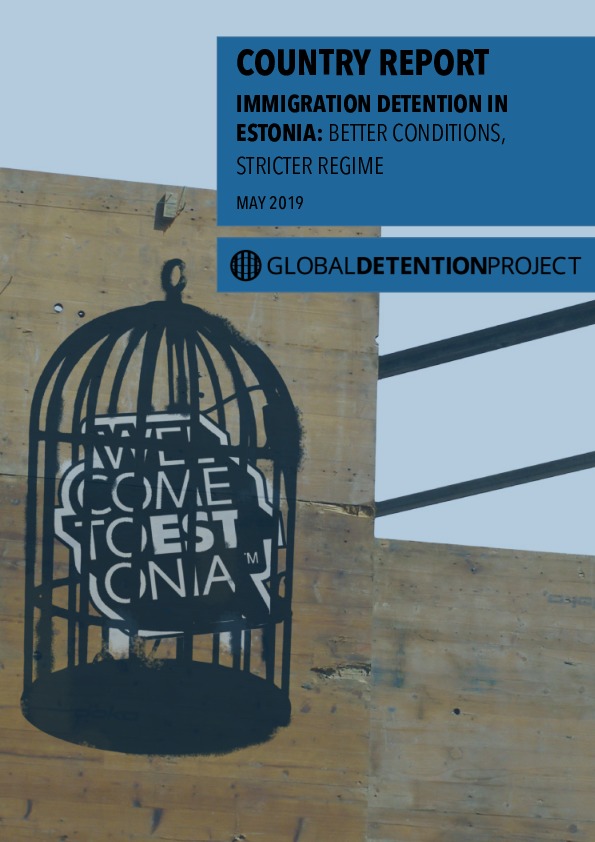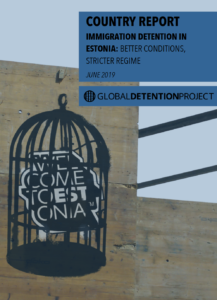Immigration Detention in Estonia (2019 Report): Largely shielded from immigration pressures due to its geography, Estonia has one of the lowest migrant-apprehension rates in the European Union and received the fewest asylum applications in 2018. Nevertheless, public discourse about migrants and foreigners is heavily marked by fear and animosity. Estonia operates one dedicated immigration detention centre, which was opened in 2018 to replace an older facility that had a long track record of riots, hunger strikes, and violence. “Alternatives to detention” are not widely used and the country’s laws do not prohibit the detention of children. View the Estonia Immigration Detention Profile.
________
Introduction to the 2019 Report
Since its independence in 1991, Estonia has maintained a largely restrictive line on immigration policy. This is rooted in part in the country’s past experience of large-scale immigration during the Cold War, when Soviet efforts to settle large numbers of ethnic Russians resulted in Estonia having one of the largest foreign populations in Europe. Because the government of the newly independent Estonia granted citizenship only to those who had resided on the territory before the Soviet takeover (and their descendants), approximately one-third of the country’s population became stateless. The numbers of stateless persons has decreased considerably since then, totalling some 76,000 as of January 2019.
The percentage of non-nationals residing in Estonia nevertheless remains one of the highest in the European Union (EU), reaching 14.7 percent as of 2017. Among the most important countries of origin of visa applicants have been Russia (109,000), Belarus (42,000), and Ukraine (15,000).
Estonia’s approach to immigration began to change in 2003, arguably in response to growing emigration rates, a phenomenon it shares with its Baltic neighbours. The government acknowledged the potential that immigration can offer the country’s economy and labour market, and a skill-based selective migration policy has since been pursued by the country’s authorities.
Also like its Baltic neighbours, Estonia has been largely shielded from the major migration events that have impacted the rest of the EU over the last decade. In 2018, the country received only 95 asylum applications, the lowest number in the EU. Estonia also has some of the lowest numbers of migrant apprehensions, which totalled less than 1,000 in 2018. Most of those apprehended are from Ukraine and Russia, who comprised 35 percent and 20 percent of all apprehensions in 2018. The number of people refused entry at the border is similar to Latvia: 1,635 in 2018 and1,175 in 2017. In 2018, Estonia returned 750 people (a figure similar to Cyprus) and 630 in 2017. In 2018, 37 percent of returnees were from Ukraine and 22 percent from Russia. Estonia detained 63 non-citizens in 2018, 61 in 2017, and 97 in 2016.
In 2018, following an Estonian Police and Border Guard Board risk analysis that concluded that the arrival of 3,000 migrants in the country would be an “emergency situation,” the country’s Interior Ministry drafted a bill to address “mass immigration.” The law, which was still being drafted by the Interior Ministry as of July 2018, would significantly curb the rights of migrants and asylum seekers. It would provide: an extension to the time period allowed for detention without an administrative court authorisation, from 48 hours to one week; the possibility of holding migrants outside the designated detention centre if it is at capacity; the option to suspend the legal requirement of housing family members together; and a reduction in the number and scope of services that are provided to migrants.
Public and political discourse is permeated by anti-immigrant rhetoric. In 2019 the Conservative People’s Party, a far-right party that says it wants to protect the country’s “indigenous Estonian” population, nearly tripled its share of seats in parliament, mirroring the rise of populist nationalist parties elsewhere in Europe. The country’s Interior Minister has voiced support for Hungarian Prime Minister Viktor Orbán’s divisive efforts to “defend” Europe from migrants, including Hungary’s construction of a mammoth razor-wire fence along its borders. These remarks came two years after the country announced plans to build a 70 million EUR fence along its border with Russia, paralleling developments in neighbouring Latvia. The 90-kilometre fence is to be equipped with warning signals, light fixtures, and boundary stones, necessary features according to the Interior Ministry, which has stated that “Estonia needs a modern state border, worthy of being the external border of Europe and NATO.” As of mid-2019, only some preparatory work has been completed and construction is expected to begin in 2020. According to reports, this delay in construction is due to the fact that costs are likely to be several times higher than initially planned.
Estonia operates one dedicated immigration detention centre. The facility was opened in 2018 in Rae municipality, outside Tallinn. It replaced a long-standing centre in Harku whose history was peppered with repeated riots, hunger strikes, and violent altercations between detainees and staff. In December 2016 for example, a riot broke out at the facility after a police officer confronted an apparently mentally ill detainee, setting off a larger confrontation between police and other detainees.During a June 2016 incident, detainees refused food and began protesting when a staff member allegedly physically mistreated a detainee, and in an incident in November 2015 the police shot rubber bullets at detainees when they refused to leave a recreation area after a disagreement between staff and one detainee. An internal investigation concluded that the use of force in the 2015 incident was inconsistent with the Law Enforcement Act.




